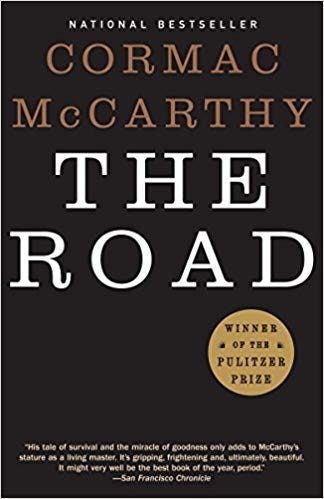What I'm Reading (No. 53): Cormac McCarthy & polar adventures
This week I blasted through Cormac McCarthy's Pulitzer-winning novel The Road. I also finished To the Edges of the Earth, about the epic 1909 expeditions to the North Pole, South Pole, and K2 (the "third" pole of highest elevation attained to that point). It was a gripping overview of an extraordinary year for exploration. Let's do it.
The Road by Cormac McCarthy

Published: 2006
Pages: 287 pages
There are a lot of unknowns in this novel when it comes to specifics: some unnamed event at an unknown time in the future has turned the world into ashy ruins. An unnamed father and son (whose ages we don't know either) are wandering this desolation, simply trying to survive. They're wondering where the next meal is coming from, trying to have some semblance of warmth at night, evading the marauders that dot the landscape. There's no denying its unforgiving bleakness.
But, this father and son are "carrying the fire." The embers of goodness are inside of them. They frequently talk about why they even continue living — most people on the planet are dead, and those who aren't want to be. Frankly, this new world doesn't offer much to live for. Yet this father and son keep on going. Carrying the fire for humanity.
I'll be damned if it's not the most beautiful depiction of a father's relationship to his son, and the desperate, illogical things he'll do out of the purity of that love, that I've ever encountered. I can't remember a novel that so perfectly combined utter desolation with utter love and hope and goodness. I came away both sad and inspired. Inspired to be a better dad, to be a stronger dad, to carry the fire and pass it along to my kids.
You should read this book.
McCarthy has written some great books (No Country for Old Men is crazy good). The Road is his best.
P.S. One last thing here: my editor-in-chief at my day job reads this book every year and wrote a great article on carrying the fire. Check it out.
To the Edges of the Earth by Edward Larson

Published: 2018
Pages: 282
In the late 19th and early 20th century, explorers were worldwide celebrities. It was called the golden age of exploration — before technology made mapping the earth and roaming its unmapped regions much easier.
"Firsts" were all the rage — they were all striving to be the first to do something. In 1909 specifically, attempts were made for three of those firsts: first to the North Pole, first to the South Pole, first up the world's second tallest peak (K2).
The men who were making these attempts — Robert Peary, Ernest Shackleton, and the Duke of Abruzzi — came from very different backgrounds, had very different approaches to their feats, and came away less known for their specific accomplishments (which in these cases weren't really achieved) than their remarkable journeys and expeditions.
While textbooks will tell you the facts of who discovered what first (though in the case of the North Pole it's hotly disputed to this day), Larson does a great job describing the sheer cold of these explorations. I drank a lot of tea reading this book.
In covering three narratives, there's not much room for Larson to delve into a whole lot of detail, so To the Edges of the Earth is a book that functions as more of an overview for the general history fan, or as something to whet the whistle into deeper reading on polar exploration.
For me, it's certainly the latter. I went and got Alone on the Ice from the library, bought The Birthday Boys on the cheap, and moved Erling Kagge's new-ish Silence: In the Age of Noise (which was already on my shelf) to the top of my reading list. It's a topic rich with stories of leadership and survival and the human will.
Any great polar exploration stories/books I should add to my list?
That's all for this week. Thank you for the space in your inbox. I really appreciate it.
-Jeremy
